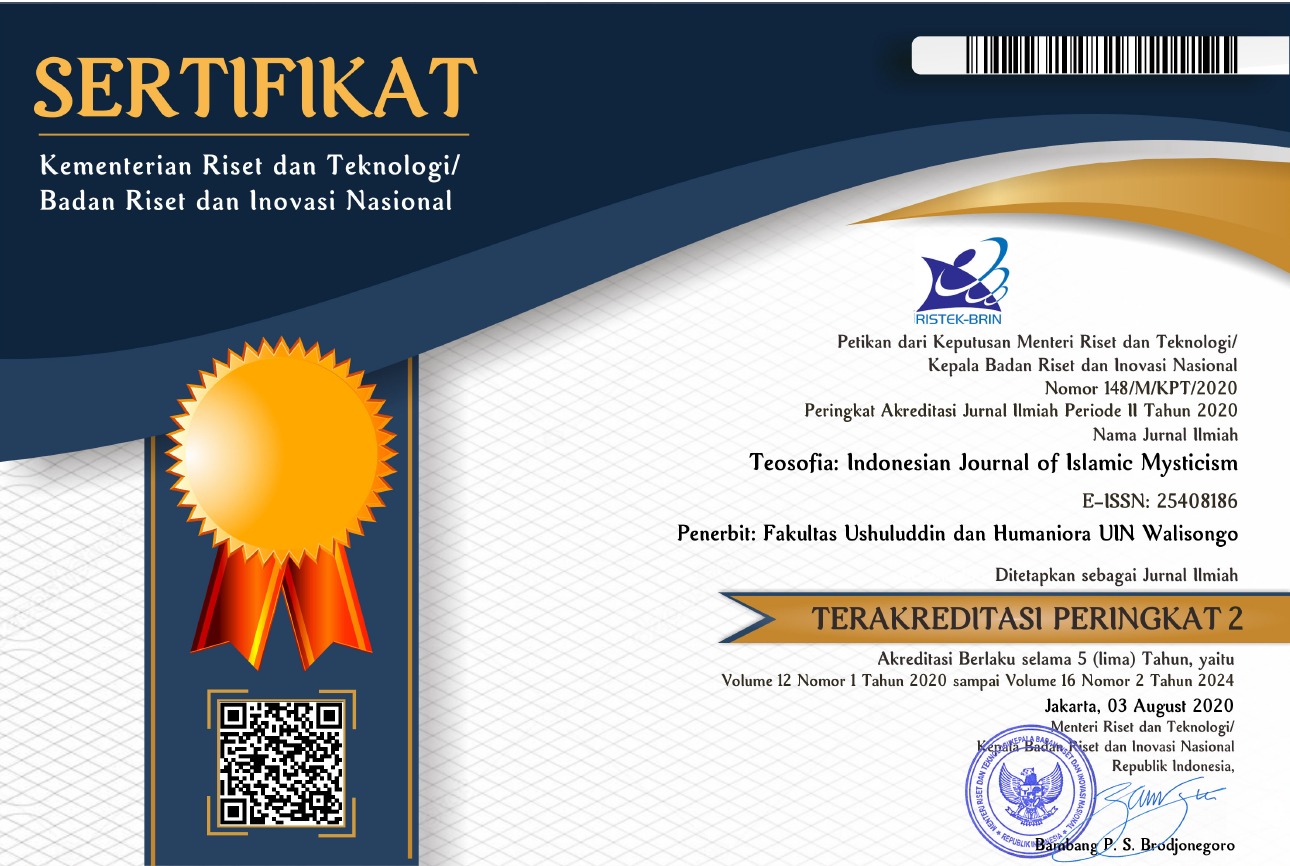The Network of Middle Eastern and Archipelagic Sufi Scholars: Tracing the Dynamics of Sufism Development in Indonesia
DOI:
https://doi.org/10.21580/tos.v13i2.19064Keywords:
network, scholars, Sufism, Sufistic, dynamics, development.Abstract
The network of Middle Eastern and archipelagic Sufi scholars can be traced from various dimensions. The Islamic arrival history in Indonesia was brought by Arab, Persian, and Indian merchants, as well as scholars. This study aims to disclose the formation of the network between Middle Eastern and archipelagic Sufi scholars and uncover the dynamics of the development of Sufi teachings in Indonesia. The method applied is qualitative-descriptive with library research. The data sources are books and scientific works. The data were then analysed using Miles and Huberman, consisting of three activities simultaneously: data reduction, data display, and conclusion. This study revealed that the network of Middle Eastern and Archipelagic Sufi scholars was created through trade, da'wah, marriage, arts, culture, and education. Therefore, the process of Islamization in Indonesia was mostly carried out through the Sufi path because of the cultural similarities between the two. The impact of the network form of these two Sufi scholars shows the dynamics of the development of Sufism from groups that (1) sympathise, those who believe that Sufism is a teaching from the Prophet, and (2) those who are antipathetic and reject the presence of Sufism and tariqa teachings, especially in Indonesia because the Prophet never exemplify these teachings.
Contribution: The results of this study provide scientific insight into the arrival of Islam in Indonesia, which occurred more through a Sufi process through a network of Sufi scholars from the Archipelago and the Middle East.
Downloads
References
Abdurrahman, Dudung, and Syaifan Nur. Sufisme Nusantara. Yogyakarta: Ombak, 2018.
Achmad Muzammil Alfan Nasrullah. “Jalan Panjang Tasawuf: Dari Tasawuf Awal Hingga Neo-Sufisme.” Spiritualita 5, no. 1 (June 30, 2021): 26–41. https://doi.org/10.30762/spiritualita.v5i1.297.
Atjeh, Aboe Bakar. Tarekat Dalam Tasawuf. Kota Bharu: Pustaka Aman, 1979.
Azmi, Wan Husein. “Islam d Aceh Dan Berkembangnya Hingga Abad XVI.” In Sejarah Masuk Dan Berkembangnya Islam Di Indonesia, edited by A. Hasymi. Bandung: Al-Ma’arif, 1993.
Azra, Azyumardi. Jaringan Ulama Timur Tengah Dan Kepulauan Nusantara Abad XVII Dan XVIII: Melacak Akar-Akar Pembaruan Pemikiran Islam Di Indonesia. Bandung: Bandung: Mizan, 1994.
Bakri, Syamsul. Akhlak Tasawwuf: Dimensi Spiritual Dalam Kesejarahan Islam. Surakarta: EFUDEPRESS, 2005.
Bistara, Raha. “Jejaring Ulama Nusantara Dengan Timur Tengah Abad XVII Dan XVIII (Studi Pemikiran Azyumardi Azra).” Al-Munqidz : Jurnal Kajian Keislaman 8, no. 3 (September 7, 2020): 309–25. https://doi.org/10.52802/amk.v8i3.263.
Devi Umi Solehah. “Konsep Pemikiran Tasawuf Falsafi (Ittihad, Hulul Dan Wihdatul Wujud).” Islam & Contemporary Issues 1, no. 2 (September 12, 2021): 1–8. https://doi.org/10.57251/ici.v1i2.53.
Faza, Abrar M.Dawud. “Dakwah Tarekat Pada Lembaga Pendidikan.” Rekognisi: Jurnal Pendidikan Dan Kependidikan 1, no. 1 (March 28, 2018). https://doi.org/10.31227/osf.io/kh98e.
Hamka. Perkembangan Dan Pemurnian Tasawwuf. Jakarta: Media Group, 2016.
Johns, A. H. “Sufism as a Category in Indonesian Literature and History.” Journal of Southeast Asian History 2, no. 1 (March 24, 1961): 10–23. https://doi.org/10.1017/S0217781100000260.
Kafid, Nur. “Sufisme Dalam Dinamika Kehidupan Masyarakat Muslim Kontemporer.” Mimbar Agama Dan Budaya 37, no. 1 (2020): 27–38. https://doi.org/10.15408/mimbar.v0i0.18232.
Kersten, Carool, Zia Anshor, and Dien Cahaya. Mengislamkan Indonesia: Sejarah Peradaban Islam Di Nusantara. Tangerang Selatan: PT. Bentara Aksara Cahaya, 2018.
Kholqillah, Ali Mas’ud. Pemikiran Tasawuf K.H. Saleh Darat Al-Samarani: Maha Guru Para Ulama Nusantara. Surabaya: Pustaka Idea, 2018.
Ma’luf, Louis. Al-Munjid Fi Al-Lughah Wa Al-’Alam. Beirut: Dar Al-Masyrik, 1975.
Munawir. 20 Tokoh Tasawuf Indonesia Dan Dunia. Buku, 2019.
Musgami, Awaliah. Tarekat Dan Mistisme Dalam Islam. Makassar: Alauddin University Press, 2013.
Nasr, Seyyed Hossein. Tasawwuf Dulu Dan Sekarang. Translated by Abdul Hadi W.M. Yogyakarta: IRCiSod, 2020.
Nasrullah, Achmad Muzammil Alfan. “Jalan Panjang Tasawuf: Dari Tasawuf Awal Hingga Neo-Sufisme.” Spiritualita: Journal of Ethics Ans Spirituality 5, no. 1 (2021): 26–41.
Nasuha. “Model Penelitian Sejarah Islam Jaringan Ulama Timur Tengah Dan Kepulauan Nusantara Abad XVII Dan XVII (Azyumardi Azra).” Saintifika Islamica 1, no. 2 (2014): 139–53. https://jurnal.uinbanten.ac.id/index.php/saintifikaislamica/article/view/272.
Nasution, Harun. Falsafah Dan Mistisisme Dalam Islam. Jakarta: Bulan Bintang, 1986.
———. Islam Ditinjau Dari Berbagai Aspeknya. Jakarta: UI-Press, 1985.
Ni’am, Syamsun. “Hamzah Fansuri: Pelopor Tasawwuf Wujudiyah Dan Pengaruhnya Hingga Kini Di Nusantara.” Epistemé: Jurnal Pengembangan Ilmu Keislaman 12, no. 1 (June 29, 2017): 261–86. https://doi.org/10.21274/epis.2017.12.1.261-286.
Pakar, Suteja Ibnu. Tasawwuf Di Nusantara Tadarus Tasawwuf Dan Tarekat. Cirebon: Aksarasatu, 2016.
———. Tokoh-Tokoh Tasawwuf Dan Ajarannya. Yogyakarta: Deepulish, 2013.
Rahman, Fazlur. Islam. Translated by Ahsin Mohammad. Bandung: Perpustakaan Salman ITB, 1984.
Ricklefs, M.C. Sejarah Indonesia Modern 1200 – 2004. Jakarta: Serambi, 2005.
Simuh. Mistik Islam Kejawen Raden Ngabehi Ranggawarsita. Jakarta: UI-Press, 1988.
———. Sufisme Jawa: Transformasi Tasawuf Islam Ke Mistik Jawa. Yogyakarta: Bentang Budaya, 2018.
Siregar, Rivay A. Tasawuf Dari Sufisme Klasik Ke Neo-Sufisme. Jakarta: RajaGrafindo Persada, 2002.
Syamsuri, Syamsuri. “Memadukan Kembali Eksoterisme Dan Esoterisme Dalam Islam.” MIQOT: Jurnal Ilmu-Ilmu Keislaman 37, no. 2 (April 14, 2013): 290–312. https://doi.org/10.30821/miqot.v37i2.84.
Syukur, M. Amin. Menggugat Tasawuf; Sufisme Dan Tanggung Jawab Sosial Abad 21. Yogyakarta: Pustaka Pelajar, 1999.
Trimingham, John Spencer. The Sufi Orders in Islam. London: Oxford University Press, Ely House, 1971.
Ulya. “Tasawwuf Dan Tarekat: Komparasi Dan Relasi.” ESOTERIK 1, no. 1 (2015): 147–65. https://doi.org/10.21043/esoterik.v1i1.1286.
Downloads
Published
How to Cite
Issue
Section
License
Copyright (c) 2024 Teosofia: Indonesian Journal of Islamic Mysticism

This work is licensed under a Creative Commons Attribution-ShareAlike 4.0 International License.
Copyright
The copyright of the received article shall be assigned to the journal as the publisher of the journal. The intended copyright includes the right to publish the article in various forms (including reprints). The journal maintains the publishing rights to the published articles. Therefore, the author must submit a statement of the Copyright Transfer Agreement.*)
Licensing

This work is licensed under a Creative Commons Attribution-ShareAlike 4.0 International License.
In line with the license, authors are allowed to share and adapt the material. In addition, the material must be given appropriate credit, provided with a link to the license, and indicated if changes were made. If authors remix, transform or build upon the material, authors must distribute their contributions under the same license as the original.
_______
*) Authors whose articles are accepted for publication will receive confirmation via email and send a Copyright Transfer Agreement.








